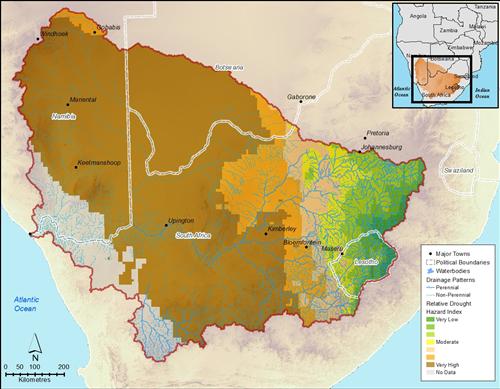Of all of the natural hazards affecting the Orange-Senqu basin, drought is the most common and devastating challenge, as water is already a scarce commodity. Variable and erratic rainfall means that the rainy season often does not start when expected and can be episodic, with an entire season’s rainfall sometimes occurring in the space of a few days. This has strong effects especially on agriculture as the most important water user.
Of the four basin countries, South Africa is most dependent on water and therefore the most susceptible to drought. However, South Africa has some capacity to manage drought impacts due to a sophisticated system of dams and transfers. Lesotho is susceptible because of distribution issues, and despite its high rainfall the southern part of the country is prone to drought. Botswana and Namibia are vulnerable to drought because of water resource shortages and the fact that they are located downstream of water users from other countries in the basin who depend on the Orange-Senqu River for water (Ionescu 2005)
Drought Hazard Index
One measure of drought risk is Drought Hazard Index (DHI), which focuses on the probability of crop failure combined with the degree of rainfall variability. Relative DHI for the Limpopo River basin is illustrated in the map below. Low DHI indicates a relatively low chance of crop failure, and High indicates an increased probability of crop failure, due mainly to rainfall variability.

Relative Drought Hazard Index for the Orange-Senqu River basin.
Source:Leira et al. 2002
( click to enlarge )
Drought Vulnerability
The see-saw effects of El Niño events and La Niña conditions over southern Africa from December to February are presented above. In most but not all cases, El Niño events cause unusually dry and warm conditions in southern Africa during the December to February months, whereas La Niña events bring unusually wet and cool conditions to the region for the same period.
The drought of 1991–92 was the most severe in recent history, affecting the entire southern Africa region including the Orange-Senqu River basin. Although there are strong indications that drought occurs cyclically in southern Africa, it is not yet possible to predict them with a high degree of certainty. Scientists have discovered a relationship between the El Niño Southern Oscillation (ENSO) and drought in southern Africa, but the correlation is not strong. In terms of hydrological drought, a mixed positive and negative correlation between the warm ENSO events and the quarterly seasonal river runoff in Southern African Rivers has been reported (Alemaw and Chaoka 2006).
